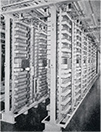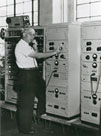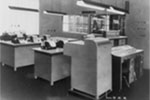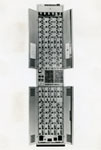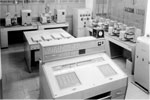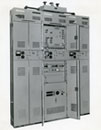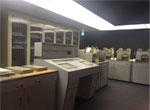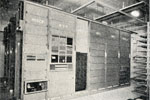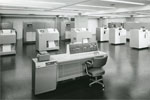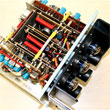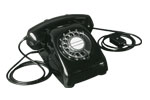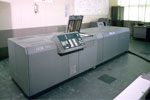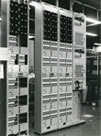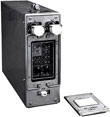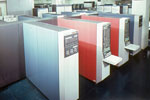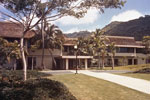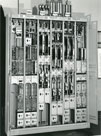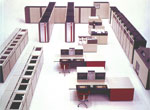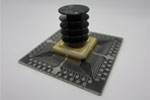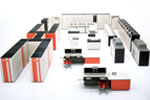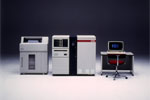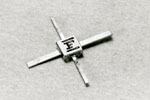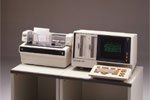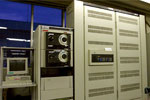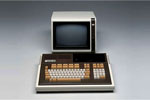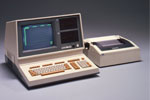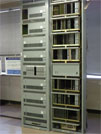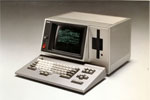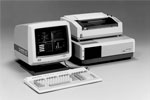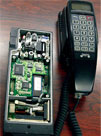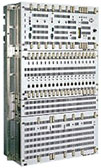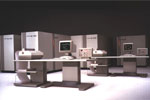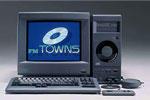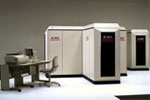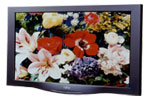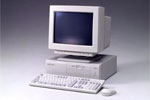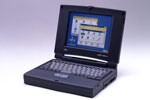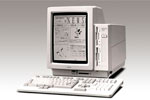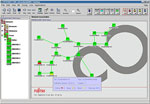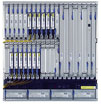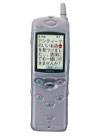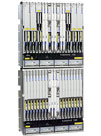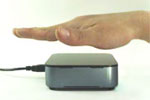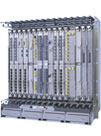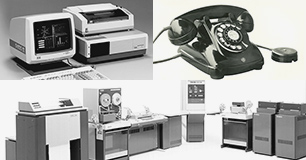Company milestones(Chronological table)
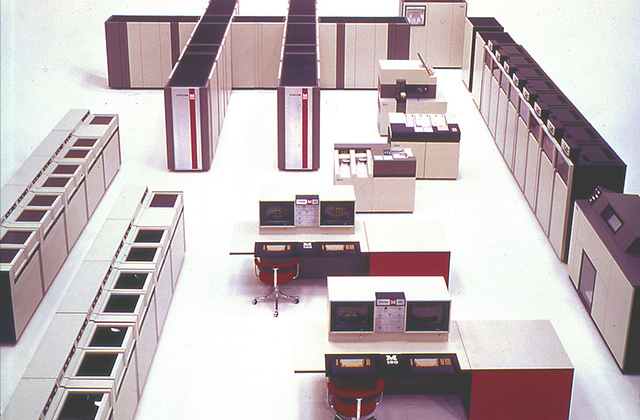
- 1. First Steps: Telecommunications (1923-1949)
- 2. The Dawn of Fujitsu's Computer Business (1950-1958)
- 3. A Decade of Bold Moves (1959-1969)
- 4. A Wave of International Standardization (1970-1979)
- 5. A Decade of Personalization (1980-1991)
- 6. A Shift to Solutions and Services (1992-2001)
- 7. Aim for a prosperous society that promotes the well-being of people (2002 - )
1. First Steps: Telecommunications (1923-1949)
-
1923Great Kanto Earthquake destroys much of Tokyo's public infrastructure
-
- Furukawa Electric Co., Ltd. and Siemens AG of Germany establish Fuji Electric Co., Ltd. to spur domestic production of generators and electric motors in Japan
-
-
1925
-
- Fuji Electric begins importing and selling telephones and "step-by-step" automatic switching systems made by Siemens AG
-
-
1929Start of Great Depression
-
1931Japan's Ministry of Post promotes domestic production of switching equipment
-
1933New Deal in U.S.A.
-
- Fuji Electric delivers its first self-developed "step-by-step" automatic switching system to Ministry of Post
-
-
1934
-
- Fuji Electric recognized by Japan's Ministry of Post as official manufacturer of "step-by-step" automatic switching systems
-
-
1935
-
- FUSI TSUSHINKI SEIZO K.K. (currently Fujitsu Limited) established as an offshoot of Fuji Electric's Communications Division (capitalized at 3 million yen with 700 employees)

(Corporate logo 1935-1961)
Uses the logo of Fuji Electric, the parent company at the time. The design was a combination of Furukawa's "f" and Germany's Siemens' "S," from which Fuji Electric derives its name.
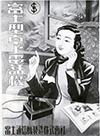 Telephone advertisement in the 1930's
Telephone advertisement in the 1930's - FUSI TSUSHINKI SEIZO K.K. (currently Fujitsu Limited) established as an offshoot of Fuji Electric's Communications Division (capitalized at 3 million yen with 700 employees)
-
-
1937
-
- Recognized by Japan's Ministry of Post as official manufacturer of non-loaded cable carrier devices
-
-
1938
-
- Completes new plant in Kawasaki (now site of Fujitsu Technology Park). Relocates company from Fuji Electric's Kawasaki plant
 New plant is completed in Kawasaki
New plant is completed in Kawasaki
-
-
1939Outbreak of Second World War
-
- Ventures into radio transmission field
-
-
1940
-
- Delivers Japan's first domestically produced "T-type" automatic switching system to Japanese Ministry of Post
- Starts production of power-line carrier devices
-
-
1942
-
- Opens Suzaka plant for mass production of telephones and telecommunications devices
-
-
1945End of Second World War
-
- At the end of WWII, Fuji Tsushinki's type 3 telephone set was approved as official telephone by Ministry of Post, and it helped restore Japan's telecommunications infrastructure devastated by the War.
-
-
1946ENIAC, the world's first electronic computer, completed in U.S.A.
-
- Establishes Tokyo Office as sales organization
-
-
1949Dodge Line Exchange rate is fixed at 360 yen to the dollar Hideki Yukawa is the first Japanese to win the Nobel Prize
-
- Lists company's stock on the newly reopened Tokyo Stock Exchange
-
2. The Dawn of Fujitsu's Computer Business (1950-1958)
-
1950Outbreak of Korean War
-
- Begins commercial production of Type 4 telephone set (monthly production reaches 5000 units)
-
-
1951Commercial broadcasting begins in Japan
-
1952Nippon Telegraph and Telephone Public Corporation is established
-
- Resumes technical cooperation with Siemens
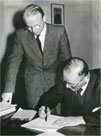 Signing agreement with Siemens AG
Signing agreement with Siemens AG
-
-
1953Japan Broadcasting Corporation (NHK) begins television broadcasts
-
- Restarts manufacture of radio communications equipment
-
-
1954
-
- Unveils miniaturized M-type carrier device and contributes to Nippon Telegraph and Telephone Public Corporation-led postwar reconstruction of communications infrastructure
- Unveils Japan's first relay type computer, the FACOM100
-
-
1957Soviet Union successfully launches world's first satellite, Sputnik 1
-
- Delivers Fujitsu's first multiplex radio device (2GHz / FM) to Nippon Telegraph and Telephone Public Corporation
-
-
1958Tokyo Tower completed
-
- Conducts field test of all-transistor switching system installed in Antarctic research ship "Soya"
- Begins delivery of first transistorized "T-type short-distance" carrier device
- Develops Japan's first numerically controlled (NC) device, the FANUC201A
- Opens Japan's first computer showroom in central Tokyo
- Unveils FACOM200 parametron computer
-
3. A Decade of Bold Moves (1959-1969)
-
1959
-
- Opens Oyama plant for mass production of telecommunication equipment
- Delivers first FACOM212 parametron computer to Japan Electronic Industry Devlopment Association (currently JEITA, Japan Electronics and Information Technology Industries Association)
-
-
1960Japanese Cabinet adopts "GNP doubling plan" Color television broadcast begins in Japan
-
- Unveils Japan's first open-loop numerically controlled device
-
-
1961Soviet Union's Vostok 1 is first successful human spaceflight
-
- Unveils Fujitsu's first transistor based large-business computer, the FACOM222
 Transistors
Transistors
-
-
1962
-
- Changes corporate logo
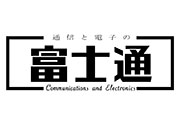
(Corporate logo 1962-1971)
Enacts the new corporate logo using the current name of Fujitsu. By starting full-scale computer manufacturing, Fujitsu reformed internal organization. As established the communications division and the computer division as two divisions, the catchphrase "Communications and Electronics" was written above and below the logo. - President Kanjiro Okada advocates "Infinite Growth"
- Starts delivery of C12MHz vacuum tube coaxial cable carrier devices (2700ch) to Nippon Telegraph and Telephone Public Corporation
- Changes corporate logo
-
-
1963
-
- Begins commercial production of Type 600 Telephone
- Unveils 4MHz coaxial transistorized terminal equipment
- Exports Japan's first computer, the FACOM212 parametron computer, to Philippines
-
-
1964Tokyo Olympics
-
- Delivers Japan's first data communications system, FACOM323, to Nikko Securities Co., Ltd.
-
-
1965
-
- Unveils FACOM230-10. Fujitsu receives 1000 orders in the first five years, making the FACOM230-10 the best-selling domestically-produced computer in Japan at that time
- Delivers FACOM230 data communications system to the Japanese Ministry of Labor
-
-
1966Annual production of Japan's electronics industry exceeds 1 trillion yen
-
- Begins mass production of integrated circuits(IC) at Kawasaki Plant
- Opens Nagano Plant for mass production of computers
- Launches "high reliability" campaign
- Begins delivery of PCM-24 carrier device
- The "FACOM Totalizator System" is completed and delivered to the Japan Racing Association, started its deliveries to NRA (Nippon Racing Association), current JRA (Japan Racing Associtation)
-
-
1967Japan's population exceeds 100 million Environmental Pollution Protection Act goes into effect
-
- Formally changes Japanese name to Fujitsu Kabushiki Kaisha (Fujitsu Limited)
- Establishes New York Representative Office as first office outside Japan
- Opens Aizu Plant for mass production of acoustic equipment and semiconductor components
-
-
1968In Japan, the number of telephone subscribers exceeds 10 million Japan's GNP ranks second in the world following the United States
-
- Establishes Fujitsu Laboratories Ltd. Research and Development Center
- Establishes Fujitsu California Inc. as Fujitsu Limited's first overseas subsidiary
- Opens Akashi Plant after Kobe Kogyo Corporation merger
- Opens Minamitama Plant
- Releases FACOM230-60 which becomes runaway best seller
- Implements Nationwide regional bank online system
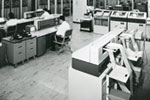 Nationwide regional bank online system
Nationwide regional bank online system- Delivers online deposit system to Dai-Ichi Bank, Ltd. (now Mizuho Bank)
-
-
1969America's Apollo 11 lands on lunar surface and first human walks on the moon
-
- Exports C400 crossbar switching system to Taiwan
- Delivers Japan's first submarine repeater (CS-10M, 900ch) to Nippon Telegraph and Telephone Public Corporation
- Completes multiplex radio communication network (2500km) in Malaysia
-
4. A Wave of International Standardization (1970-1979)
-
1970Osaka Expo
-
- Fujitsu Information Processing System Laboratory construction completes.
-
-
1971Dollar Shock
-
- Invests in Amdahl Corporation (U.S.)
- Delivers D10 analog electronic switching system
- Starts commercial production of Model 600 push-button telephone
- World's first practical application of "self-holding reed" switches
- Fujitsu and Hitachi corporation started for development of next generation computer series.
-
-
1972
-
- Changes corporate logo
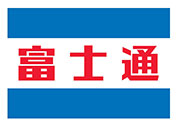
(Corporate logo 1972-1988)
Enacts the new corporate logo. It was designed under the concepts of "peace" in blue, "passion" in red, and "purity" in white. - Establishes Japan America Institute of Management Science (JAIMS) in Hawaii with the aim of developing business leaders
- FUJITSU FANUC LTD is established. (current FANUC Corporation)
- Develops Japan's largest pollution monitoring system implemented in Kawasaki city
- Changes corporate logo
-
-
1973Japan changes to flexible exchange rate system First Oil Shock
-
- Delivers world's first Single Channel Per Carrier(SCPC) satellite communications system (a data line between the U.S. and Spain)
-
-
1975
-
- Delivers Amdahl Corporation's 470 V/6 mainframe computer to NASA
- Exports Japan's first submarine coaxial cable system (210km between West Germany and Sweden)
-
-
1976
-
- Lists stock on Frankfurt Stock Exchange
- Opens Numazu plant for production of large-scale computers
- Ships first IBM compatible FACOM M Series computer
-
-
1977Japanese baseball player Sadaharu Oh hits 756th home run (world record)
-
- FACOM230-75 APU, Japan's first supercomputer, developed
-
-
1978Second Oil Shock Narita International Airport in Japan opens
-
- Concludes Joint-venture agreement with Siemens AG in computing products field
- Receives order from Satellite Business Systems (U.S.) for world's first satellite communications burst modem
- Commercializes world's first 64-Kbit RAM (dual power supply)
-
-
1979Nippon Telegraph and Telephone Public Corporation completes nationwide direct dial telephone network in Japan
-
- Participates in Bell Labs' commercial viability tests of American-type cellular handsets
- Announces Japanese Processing Extended Features (JEF), making it possible to process Japanese kanji characters
-
5. A Decade of Personalization (1980-1991)
-
1980
-
- Becomes largest computer company in Japan
- Opens Iwate Plant (merges memory chip mass production line from Aizu Plant)
- Fujitsu Laboratories succeeds in development of High Electron Mobility Transistor (HEMT)
- Introduces Japanese word processor, OASYS100
-
-
1981Number of telephone subscribers exceeds 40 million in Japan
-
- Opens San Diego Plant in California, U.S.A., and begins local production of semiconductors
- Lists stock on London Stock Exchange
- Receives orders from Singapore for world's first fully digital electronic switching system, the FETEX-150
- Delivers Fujitsu's first optical submarine repeater to Nippon Telegraph and Telephone Public Corporation
- Introduces Fujitsu's first personal computer, FM-8
- Introduces Fujitsu's first business-use personal computer, FACOM9450
-
-
1982
-
- MCI project (135 Mbps fiber optical system) is opened to traffic
-
-
1983
-
- Lists stock on the Zurich, Basel, and Geneva stock exchanges (merged now as the SWX Swiss Exchange)
- Introduces world's first CMOS 256 KB EPROM
-
-
1984Deregulation of Japanese telecommunication market U.S. based AT&T is split up
-
- Opens Dallas Plant in U.S.
- Opens Mie Plant for prototype development and mass production of large-density memories and large-scale gate arrays
- Opens Wakamatsu Plant for prototype development and mass production of customized LSI products
- Introduces Corporate Information Network System (COINS)
- Starts car phone production
- FACOM K series leads small business computer market in Japan
-
-
1985Nippon Telegraph and Telephone Public Corporation privatized Science World Expo, Tsukuba '85 in Japan Japan longitudinal fiber-optic system completed
-
- Exhibits at Science World Expo, Tsukuba "FUJITSU Pavilion"
 Tsukuba "FUJITSU Pavilion"
Tsukuba "FUJITSU Pavilion"- Delivers 405M optical transmission system for New York-to-Washington MAFOS project
- Launches FENICS Value Added Network (VAN) service
-
-
1988Seoul Olympics
-
- Launches world's first commercial ISDN service, running on Fujitsu FETEX-150 digital switching system in Singapore
-
-
1989Berlin Wall falls in Germany
-
- Adopts new corporate logo
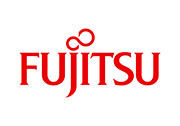
With the globalization, the present corporate logo in English was enacted. The infinity mark at the top of the "j" and "i" at the center of the "FUJITSU" symbolizes the "Earth" and "Sun," representing the expanse of space and infinite possibilities. FUJITSU Red (red) symbolizes challenging, human and exciting companies.
- Unveils FM TOWNS 32-bit "hyper-media" personal computer
- Adopts new corporate logo
-
-
1990Iraqi troops invade Kuwait German reunification
-
- Takes 80% stake in UK-based International Computers Limited (ICL)
- Releases M-1800, the world's fastest ultra-large general-purpose computer
-
-
1991Outbreak of the Gulf War
-
- Launches DS/90 7000 Series UNIX computer
-
6. A Shift to Solutions and Services (1992-2001)
-
1992
-
- Unveils PROPOSE, an integrated services framework for information and communication systems
- Releases VPP 500, the world's fastest vector parallel supercomputer
-
-
1993
-
- Selected as a supplier of broadband-ISDN switching systems by a U.S. carrier; receives order for FETEX-150, the world's first commercial Asynchronous Transfer Mode(ATM) switching system
- Introduces FMV Series of personal computers supporting Microsoft Windows
-
-
1995Great Hanshin-Awaji Earthquake Microsoft releases Windows 95
-
- Opens Tatebayashi System Center as base for outsourcing services
- Releases FMV-BIBLO, B5-size software preinstalled notebook computer
- Introduces new GS8000 series, global server employing the world's fastest CMOS general-purpose processor and parallel processing technology
- Commercializes world's first 42-inch color plasma display
-
-
1997Hong Kong reverts to China
-
- Amdahl Corporation becomes a wholly owned subsidiary of Fujitsu
- Announces SOLUTIONVISION, a new business architecture featuring network computing solutions
-
-
1998Nagano Winter Olympics Google established EU introduces the euro currency
-
- ICL becomes a wholly owned subsidiary
- Fujitsu Laboratories Limited awarded Medal of Honor with Purple Ribbon from Japanese Government for development of high electron mobility transistors (HEMT)
- Develops NAND-type flash memory
-
-
1999i-mode (first cell phone internet service) released in Japan Y2K
-
- Announces "Everything on the Internet" business strategy
- Introduces environmental accounting system, a first in Japan
- Announces Fujitsu Siemens Computers, a joint venture with Germany-based Siemens AG
- Merges internet service InfoWeb, with online information service, NIFTY-serve, to form @nifty internet service provider
- Succeeds in world's first 1 terabit/sec optical Wavelength Division Multiplexing (WDM) transmission over a distance of 10,000km
- Releases first i-mode cell-phone, Digital mova F501i HYPER
-
-
2000Sydney Olympics Proportion of people in their 20s with cell-phones reaches 90% in Japan IT bubble bursts
-
- Unveils world's highest capacity (1.76Tbps) optical Wavelength Division Multiplexing (WDM) transmission system
-
-
2001September 11 attacks in United States
-
- Begins delivery of IMT-2000 switching system
- Releases mova F671i cell-phone (employing universal design)
- Releases FMV-BIBLO LOOX, world's first mobile computer offering built-in 64Kbps wireless data transmission
-
※ All product names and other proper names are trademarks or registered trademarks of their respective companies.
7. Aim for a prosperous society that promotes the well-being of people (2002 - )
-
2002
-
- Renames ICL, U.S. based companies DMR and Amdahl Corp. as Fujitsu Services Holding PLC, Fujitsu Consulting Holdings, Inc. and Fujitsu IT Holdings, Inc. respectively
- Commences world's first large-scale pilot manufacturing of 90-nm LSI devices at Akiruno Technology Center
- Establishment of The FUJITSU Way (current Fujitsu Way)
- Releases GS21 600, the world's fastest mainframe
- Unveils "TRIOLE" platform-integration strategy
- Pioneers use of energy-efficient, biodegradable plastic in notebook computers
-
-
2003Apple launches iTunes
-
- Announces strategic collaboration to develop mission-critical enterprise servers with Intel Corporation
- Opens Fujitsu Solution Square, its center for solutions business
- Announces global partnership in mission-critical Linux solutions field with Red Hat
- Releases FOMA F205i, marking full-scale entry into 3rd generation cell-phone market
- Fujitsu Laboratories Limited awarded Medal of Honor with Purple Ribbon from Japanese Government for Surface Acoustic Wave(SAW) filter
- PalmSecure contactless palm vein authentication technology is developed
-
-
2004Athens Olympics
-
- Obtains ISO14001 certification for environmental management
- Expands strategic global alliances, forming partnerships with Sun Microsystems, Microsoft Corp., and Cisco Systems, Inc.
- Releases PRIMEPOWER, the world's first UNIX servers using 90-nm semiconductor technology
- Fujitsu Laboratories Limited awarded Medal of Honor with Purple Ribbon from Japanese Government for Plasma Display Panel
-
-
2005Kyoto Protocol comes into effect
-
- Begins production of 90 -nm logic LSI devices employing 300mm wafers (Mie 300mm Fab. No.1) in Mie Plant in Japan
- Obtains ISO 14001 certification for consolidated subsidiaries in Japan collectively
- Concludes global technology partnership agreement with U.S. based EDS
- Releases PRIMEQUEST, the world's most powerful mission-critical IA server
- Releases next-generation router, CSR-1, developed under a strategic tie-up with Cisco Systems, Inc.
- Releases Japan's first UHF band RFID products
- Launches globally PalmSecure contactless palm vein authentication equipment business
- Develops world's first highly integrated LSI for use in WiMAX-compliant base stations and subscriber stations
- Releases processor conforming to the latest H.264 standard for video compression
-
-
2006Terrestrial digital TV one-segment broadcasting begins in Japan
-
- Announces expansion of global partnership in services area with SAP AG
- Releases World's first 300GB 2.5" serial ATA hard disk drive
-
-
2007
-
- Begins operations for 65nm technology at Mie plant in Japan (Mie 300mm Fab.No.2)
- Releases Solaris/SPARC server,"SPARC Enterprise", achieving new standards in speed and reliability in open systems
- Delivers Castor oil based biodegradable plastic
- Sales of "universal designed" mobile phones surpass the 10-million-unit mark
-
-
2008Beijing Olympics
-
- Establishes LSI Subsidiary, Fujitsu Microelectronics Limited
- Attained No.1 share in North American's optical transmission system (Metro WDM) market
-
-
2009Inauguration of President Obama Pandemic declared for new influenza
-
- Fujitsu Siemens Computers GmbH becomes a wholly owned subsidiary, and name is changed to Fujitsu Technology Solutions (Holding) B.V.
-
-
2010Apple launched the iPad
-
- Fujitsu Trusted Cloud Square is opened, a facility for testing cloud computing systems
- Introduces new brand promise "shaping tomorrow with you"
- Tokyo Stock Exchange (TSE) launches Next-Generation "arrowhead" Trading System
-
-
2011The Great East Japan Earthquake
-
- Supercomputer "K computer" Takes Consecutive No. 1 in World Ranking
- Achieves world's fastest processing speed of 10.51 petaflops and 93.2% operating efficiency -
* The K computer is jointly developed by RIKEN and Fujitsu. "K" comes from the Japanese Kanji letter "Kei" which means ten peta or 10 to the 16th power.
- Supercomputer "K computer" Takes Consecutive No. 1 in World Ranking
-
-
2012London Olympics
-
- Opens First Data Center in China
- Fujitsu Group in World's First of Third-Party Certification for ISO 22301, the International Standard for Business Continuity Management Systems
- Agriculture cloud solution, Akisai, is launched
-
-
2013Existence of Higgs boson confirmed Mount Fuji is granted World Heritage status
-
- Fujitsu Sets Out its "Fujitsu Technology and Service Vision"
New structure of technologies and services based on Fujitsu's vision of a "Human Centric Intelligent Society". - Systemizes Fujitsu products and services for cloud, big data, mobility and security to accelerate innovation for customers and companies.Launches the FUJITSU Cloud, FUJITSU Big Data, FUJITSU Mobile and FUJITSU Security Initiatives between 2013-2014.
- Fujitsu Sets Out its "Fujitsu Technology and Service Vision"
-
-
2014
-
- Announces New Global Matrix Organization
- Accelerate the globalization of its business by creating a new organization structure consisting of five regions – EMEIA (Europe, Middle East, India and Africa), Americas, Asia, Oceania and Japan - Launched IoT platform for creation of business and the formation of a global ecosystem
- Announces New Global Matrix Organization
-
-
2015
-
- Appoints as an official Gold Partner of the Tokyo 2020 Olympic and Paralympic Games in the category of Data Center Hardware
- 80th anniversary of its foundation
- Launches MetaArc, its Digital Business Platform
- Takes systematic approach to artificial intelligence with "Human Centric AI Zinrai"
-
-
2016
-
- Fujitsu Laboratories develops new architecture that rivals quantum computers in utility
-
-
2017
-
- Named to FORTUNE Magazine's 2017 List of "World's Most Admired Companies" for 5th consecutive year
- Establishes "FUJITSU Climate and Energy Vision," a medium- to long-term environmental vision for 2050
-
-
2018
-
- Launches Fujitsu Quantum-inspired Computing Digital Annealer Cloud Service
- The International Gymnastics Federation decides to Implement Fujitsu's Judging Support System
-
-
2019
-
- Event Support Service featuring "Ontenna", a user interface device to sense sound with body, launched
- Fujitsu Group External Advisory Committee on AI Ethics established
-
-
2020
-
- Establishes "Ridgelinez Limited"
- Japan's first commercial local 5G operation started
- Supercomputer Fugaku takes No. 1 in World Rankings, TOP 500, HPCG, HPL-AI, and Graph 500
* Fugaku was jointly developed by RIKEN and Fujitsu. - Revamps corporate philosophy "Fujitsu Way"
- Pushes on 'New Normal', redefining working styles
- Establishes "Fujitsu Japan Limited"
-
-
2021
-
- Establishes new business brand Fujitsu Uvance
-
-
2022
-
- Expanded job-based human resource management to include regular employees
-
※ All product names and other proper names are trademarks or registered trademarks of their respective companies.
Share this page

